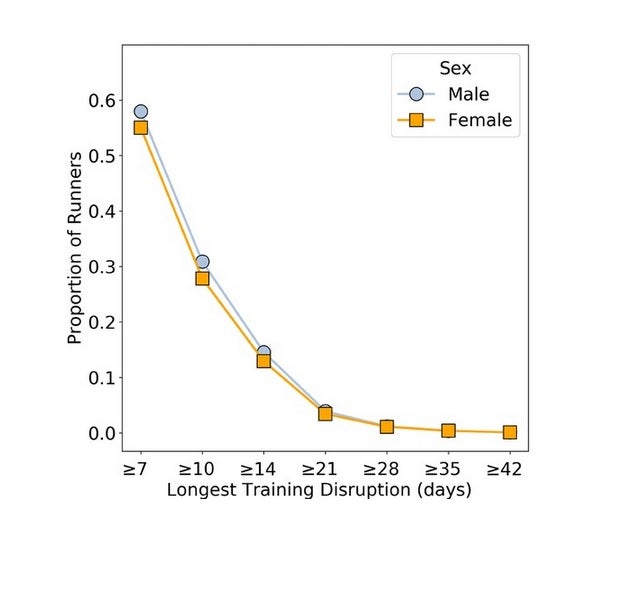Final fall, I made a decision to run a cross-country season for the primary time in just a few years. I began hammering a weekly over-hill-and-dale interval session with pals, and partway by way of considered one of these exercises—cease me for those who’ve heard this one earlier than, fellow middle-aged individuals—I felt a faint pop in my proper hamstring. It didn’t really feel horrible, however I’m a cautious man. After just a few seconds of denial, I finished operating and headed residence.
The subsequent morning is when the exhausting choices began. I may really feel the tweak in my hamstring, however was nonetheless able to operating if I wished to. My goal race was simply over 5 weeks away. How ought to I weigh the chance of creating the hamstring worse—maybe dangerous sufficient to finish my season totally—with the lack of health that might start to build up if I took day without work? I’ve been operating lengthy sufficient to know that just a few days off isn’t the top of the world, however I didn’t have a exact sense of how a lot health I’d lose with every passing day, which made weighing the professionals and cons tough.
There are just a few other ways you’ll be able to strategy this. One is to mannequin your particular person coaching responses over time to be able to give you customized parameters describing how rapidly your physique accumulates health and fatigue. That’s the “efficiency engineering” methodology advised by coaches comparable to Phil Skiba. On the reverse finish of the spectrum, you’ll be able to mine large datasets for common insights about what occurs to individuals such as you once they involuntarily miss some coaching. That’s what a staff at College Faculty Dublin, led by doctoral pupil Ciara Feely, does in a brand new paper revealed in Frontiers in Sports activities and Energetic Residing.
Feely and her colleagues used a large set of coaching knowledge uploaded to Strava by almost 300,000 marathoners between 2014 and 2017. (I wrote about one other evaluation of Strava knowledge led by Barry Smyth, one of many co-authors of the brand new paper, in 2020. That one used coaching and racing knowledge to estimate essential pace.) Throughout the dataset, Feely’s staff recognized 43,933 runners who had accomplished a marathon after lacking a minimum of seven consecutive days of coaching someday through the 12 weeks previous to the race and accomplished one other marathon with no coaching disruptions. The query: how a lot slower, if in any respect, did they run when their coaching was disrupted?
The very first thing to notice is that coaching gaps had been extraordinarily widespread among the many runners within the examine. Among the many full dataset of almost 300,000, greater than half had a minimum of one hole of a minimum of seven days throughout their 12-week marathon build-up, and almost a 3rd had a ten-day hole. Right here’s the proportion of runners (on the vertical axis) as a perform of their longest pre-marathon coaching disruption (on the horizontal axis):

There are nonetheless some runners—someplace between 10 and 15 p.c of them—who straggle as much as the beginning line of their marathon regardless of lacking two steady weeks of coaching, which is… spectacular, in a manner. Or, alternately, it could be an indication that the info isn’t good. All of the researchers have is the uncooked Strava knowledge. They don’t know why these coaching gaps seem: possibly it’s a pulled hammy, possibly it’s a misplaced charging cable for the GPS watch.
Even when the info is ideal, it’s additionally value noting who we’re speaking about. The typical runner within the examine was about 40 years outdated, operating 25 miles per week in three runs. The lads (233,000 of them) had common marathon occasions of just below 4 hours, whereas the ladies (59,000) averaged 4:24. Within the taxonomy of athlete standing, this inhabitants straddles the border between recreationally lively and skilled runners. You don’t count on Eliud Kipchoge to indicate up if he misses two weeks of his marathon build-up. Whether or not he’d undergo roughly than the common runner from the consequences of missed coaching isn’t apparent, however both manner you’ll be able to’t assume the outcomes would scale to runners like him.
With these limitations in thoughts, right here’s the underside line: runners who missed a 7- to 13-day stint of coaching throughout their 12-week build-up ran 4.25 p.c slower than once they had an uninterrupted build-up. If the hole was two weeks, they slowed by a bit greater than 6 p.c. At three weeks, it was about 7.5 p.c. At 4 weeks—come on, let’s be critical right here.
You possibly can slice and cube the info to get some additional insights. Males gave the impression to be considerably extra affected than ladies by missed coaching, a discovering the researchers recommend might outcome from the truth that males are inclined to overestimate their health and hit the wall extra ceaselessly, even when their coaching has gone properly. Youthful runners additionally undergo extra, as do sub-four-hour marathoners. You possibly can give you varied tales to elucidate these outcomes based mostly on coaching patterns or psychological variations or no matter—however with out knowledge to inform us which story is true, there’s not a lot level in speculating.
One sample that does appear notable, or a minimum of logical, is that missed coaching between eight and 12 weeks earlier than race day has much less impact than if it occurs between three and 7 weeks earlier than the race. (The researchers didn’t analyze missed coaching within the final three weeks, since that could be a part of a taper.)
Ultimately, the steerage you get right here isn’t going to be as fine-tuned as a customized “efficiency engineering” calculation. The upside is that you just’ve acquired a quantity proper right here, or a minimum of a spread of numbers, that may aid you regulate your race objectives for those who do hit a speedbump on the street to your subsequent marathon. As for my hamstring, I took two days off and some extra days simple and made it by way of the remainder of the season—till the 6K mark of my season-ending 8K race, when it blew once more. It was gentle sufficient that I made it to the end with out slowing a lot, so I’d name {that a} completely judged damage response.
For extra Sweat Science, be part of me on Twitter and Fb, join the electronic mail e-newsletter, and take a look at my ebook Endure: Thoughts, Physique, and the Curiously Elastic Limits of Human Efficiency.
Supply By https://www.outsideonline.com/well being/training-performance/missed-marathon-training-study-2023/



